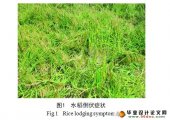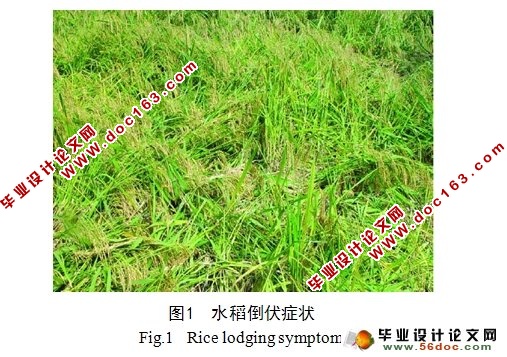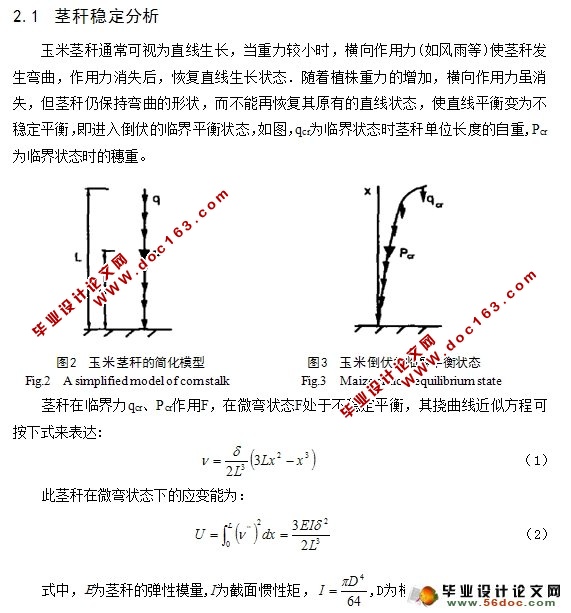作物抗倒伏的力学机理研究

作物抗倒伏的力学机理研究(选题审批表,任务书,开题报告,中期检查表,毕业论文16000字)
摘 要:倒伏是由外界因素引发的作物植株茎秆从自然直立状态到永久错位的现象,不同学者对倒伏的类型划分不同。一般意义上讲,倒伏主要划分为根倒和茎倒。根倒是直立茎秆由根茎的倾斜而产生的歪倒,茎倒是指基部茎节的弯曲或折断,主要是在表层土壤紧实的情况下,发生暴风雨引起,也可能由病虫害引发。从力学机理上讲,根倒是茎秆弯曲刚度问题,茎倒是茎秆受压屈曲问题。本课题旨在建立农作物茎秆倒伏的力学模型,利用力学理论和方法,对于弯曲刚度问题分析其影响因素。对于屈曲问题,给出适用于多种农作物如:油菜、亚麻、玉米、水稻、小麦、屈曲失稳临界力的表达式,临界力越大,抗倒伏能力越强。研究临界力的影响因素,结合作物的生理与栽培,提出提高作物抗倒伏能力的措施。
关键词:根倒;茎倒;弯曲刚度;临界力;力学模型。
On The Mechanical Principle of Crop Lodging
Abstract:Lodging is a crop plant stalk caused by external factors to the phenomenon of permanent dislocation from the natural upright position, different scholars on the type of lodging is divided into different. General sense, the lodging is mainly divided down for root and stem down. Against the failure of the root touches upright stalk produced by the tilt of the roots, stem touches the bending or breaking of the base of the internode, mainly in the surface soil compaction, the storm caused, may also be caused by pests and diseases. Mechanical mechanism speaking, the root touches stalk bending rigidity of the stem touches stalk compression buckling. This project aims to establish the mechanical model of crop stalk lodging, use of mechanical theory and methods to analyze the influencing factors for the bending stiffness. For the buckling problem, given expression in a variety of crops such as: rape, flax, corn, rice, wheat, buckling critical force, the greater the critical force, the stronger lodging resistance. Critical force influencing factors, combined with the physiology and cultivation of crops, proposed measures to improve crop lodging resistance.
[资料来源:http://www.doc163.com]
Key words:root down;STALK;bending stiffness;critical;critical force;mechanical model.
论文的主要内容
本文对作物的抗倒伏力学性能进行了研究,通过调查文献获得资料,理论计算数值,模拟作物抗倒伏的力学原理,来进行探讨,主要做了以下几个方面的工作。研究几种优良作物茎秆的生物力学性质,并对文献的数据进行相关性分析,研究主要集中在作物茎秆材料生物力学性质试验测定,生物力学抗倒伏评价以及作物形态特性指标与倒伏性的相关性研究,对试验测试的数据进行了相关性分析,在此基础上对影响关系进行理性探讨。对不同时期作物茎秆的力学特性进行了一些试验和研究,分别测试了两个品种各节间在不同生长期的弹性模量E和惯性矩以及各节间抗弯特性的变化。根据文献数据建立根倒伏系数,对作物的抗倒伏能力进行评定。利用力学理论和方法,对于弯曲刚度问题分析其影响因素,对于屈曲问题,建立农作物茎秆倒伏的力学模型,给出适用于多种农作物的屈曲失稳临界力的表达式,研究临界力的影响因素,结合作物的生理与栽培,提出提高作物抗倒伏能力的措施。
[来源:http://Doc163.com]


目 录
摘要 …………………………………………………………………………………………1
关键词 ………………………………………………………………………………………1 [来源:http://Doc163.com]
1 前言………………………………………………………………………………………2
1.1 研究的目的与意义………………………………………………………………2
1.2 国内外研究相关进展……………………………………………………………3
1.3 论文的主要内容…………………………………………………………………4
2 作物茎秆的力学分析……………………………………………………………………5 [资料来源:http://doc163.com]
2.1 茎秆稳定分析……………………………………………………………………5
2.2 倒伏内力分析……………………………………………………………………7
2.2.1 弯曲强度…………………………………………………………………7
2.2.2 弯曲刚度…………………………………………………………………7 [版权所有:http://DOC163.com]
2.3 倒伏相关力学指标的确定………………………………………………………7
3 同期作物茎秆力学特性实验的方案设计………………………………………………7
3.1 实验目的…………………………………………………………………………8
3.2 设备及试样………………………………………………………………………8
3.2.1 实验设备…………………………………………………………………8 [资料来源:https://www.doc163.com]
3.2.2 试样选取…………………………………………………………………8
3.3 实验原理及方法…………………………………………………………………8
3.3.1 实验原理…………………………………………………………………8
3.3.2 实验方法 ………………………………………………………………10
4 不同时期作物茎秆力学特性实验的方案设计 ………………………………………11
[版权所有:http://DOC163.com]
4.1 实验目的 ………………………………………………………………………11
4.2 材料及试样 ……………………………………………………………………11
4.3 实验原理及方法 ………………………………………………………………11
4.3.1 实验原理 ………………………………………………………………11
4.3.2 实验方法 ………………………………………………………………12 [版权所有:http://DOC163.com]
5 建立倒伏系数评定作物抗抗倒伏机能的方案设计 …………………………………13
5.1 实验目的 ………………………………………………………………………13
5.2 材料及试样 ……………………………………………………………………13
5.3 实验原理及方法 ………………………………………………………………13
6 数据采集与分析 ………………………………………………………………………14 [资料来源:Doc163.com]
6.1 同期作物茎秆力学指标沿高度的变化 ………………………………………14
6.2 茎秆生物力学性质与形态特性的相关性分析 ………………………………17
6.3 作物生长期对作物抗倒伏能力的影响 ………………………………………20
6.3.1 惯性矩 …………………………………………………………………20
6.3.2 弹性模量 ………………………………………………………………21 [来源:http://www.doc163.com]
6.3.3 抗弯刚度 ………………………………………………………………22
6.3.4 结论 ……………………………………………………………………22
6.4 倒伏系数评价根倒伏抗性的准确性 …………………………………………23
6.4.1 抗倒伏评价方法 ………………………………………………………23
6.4.2 大麦根倒伏的倒伏系数与其构成因素的通径分析 …………………25
7 抗倒伏的措施 …………………………………………………………………………26
7.1 抗倒育种 ………………………………………………………………………26
7.2 混作防倒 ………………………………………………………………………26
7.3 栽培措施 ………………………………………………………………………26
7.3.1 播种时期… ……………………………………………………………26
7.3.2 种植密度 ………………………………………………………………26
7.3.3 肥水运筹 ………………………………………………………………27
8 研究结论… ……………………………………………………………………………27
[资料来源:https://www.doc163.com]
参考文献 …………………………………………………………………………………28
致谢…………………………………………………………………………………………28
[来源:http://Doc163.com]
